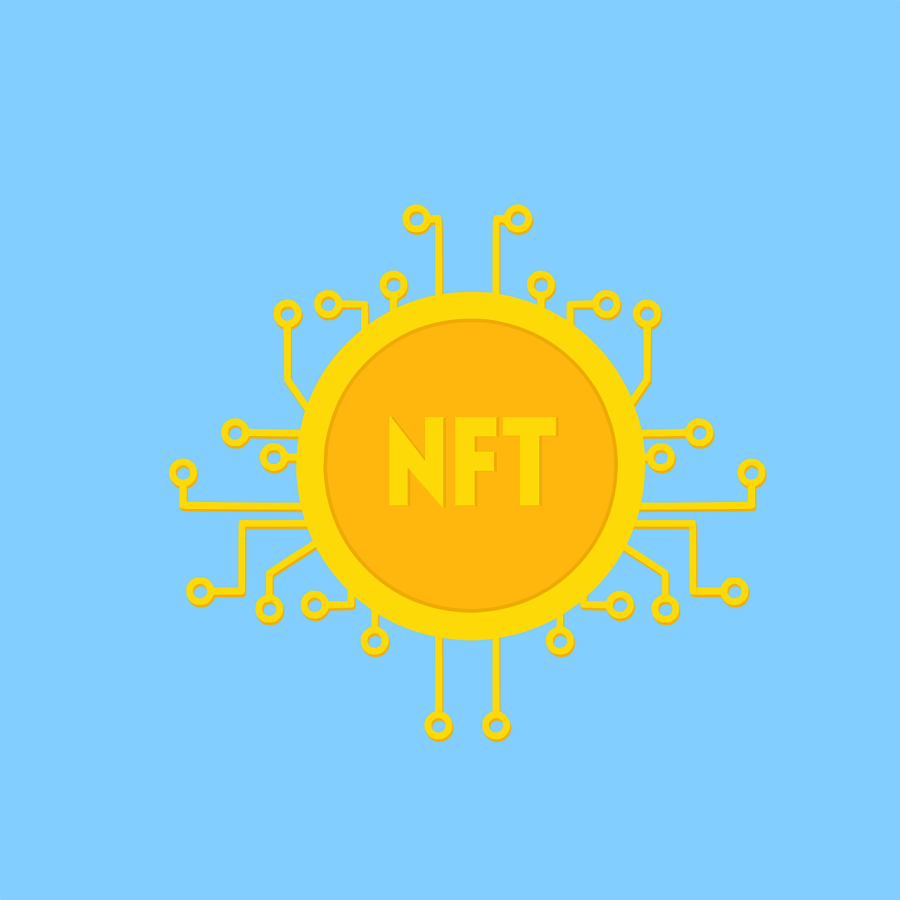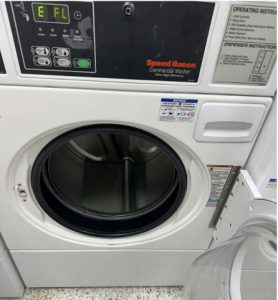NFTs: No freaking thanks
Feb 10, 2022
We are in a new age of paranoia. You have to bite your tongue every time your one Terminally Online friend relays the benefits of investing in Bitcoin. Every day, we scan the Twitter feed and Instagram stories of all of our favorite bands, companies and celebrities and pray to whatever deity will listen that we don’t find mention of this new fad –– the proof that the people you have parasocially clung onto aren’t total morons. And more than once, we have been let down.
I am, of course, referring to non-fungible tokens, or NFTs. They are an extension of cryptocurrency and have been picking up steam over the last year. This has been particularly prominent in celebrity and corporate circles. Recently, Twitter announced that users would be able to upload NFTs to serve as their profile pictures, distinguished by a hexagonal shape as opposed to the standard circle. Companies, like Ubisoft and Taco Bell, have begun to implement NFTs into their brand. The NBA All-Star Game, which is to be held here in Cleveland later this month, has created a city-wide NFT scavenger hunt for the event. Countless celebrities, like Linkin Park rapper Mike Shinoda, Oscar-winning actress Brie Larson and surrealist comedian Eric Andre have released, bought or indicated support for the fad. By now, we’ve all seen the creepy Jimmy Fallon-Paris Hilton interview where they robotically stumped for NFTs like there was a gunman off-camera holding their loved ones hostage. Obviously, NFT’s are becoming a staple of the 2020s media scene.
Which is bad. Very, very bad.
To explain why, you have to know what an NFT is, which Mashable does a terrific job of explaining. Essentially, NFTs are a special type of cryptocurrency located on the blockchain (a shared, immutable ledger that facilitates the process of recording transactions and tracking assets in a business network; essentially where cryptocurrency is stored). Currency, typically, is fungible, meaning there is no difference between ownership of two different $1 bills, as they both have the exact same value. NFT’s, on the other hand, are non-fungible, and cannot be interchanged in the same way. “The Scream” by Edvard Munch and “The Tragedy” by Pablo Picasso are both paintings, sure, but they are unique and cannot be swapped out for each other. As the website states, “…every NFT is unique and immutable, created on the blockchain and tied to a singular object such as a digital artwork or photograph.”
You might be thinking to yourself, “That sounds overly complicated, but nothing too bad. What’s the big deal?”. Well, the fact is there are several reasons NFT’s are actively harmful, as well as just plain stupid.
The most common one you’ll hear (and the most important one, if we’re being honest) is their environmental impact. You see, a blockchain works by “mining” cryptocurrency using computers. Entire warehouses of supercomputers are needed to produce crypto like Bitcoin and NFTs. As such, the carbon footprint required to power and enable NFTs can be equivalent to that of a small country. Now, as this article posits, that is nowhere near the carbon footprint of other industries like air travel and agriculture, so why single out NFTs? My answer is that one, we need to work to decrease the carbon outputs of both of those as well, and two, both air travel and agriculture are badly needed to sustain our modern world, so there’s a trade-off (note that is not a justification of their respective climate effects). I am not willing to have our planet irreversibly damaged by crappy clipart of monkeys peddled by nerds online. And while some have posited that eco-friendly NFTs, powered by solar energy and hydroelectric systems, are achievable, the fact of the matter is, at the present moment, the carbon footprint generated by the mining of NFTs has simply zero trade-off and functions only to further harm our already-dying planet.
Next is their reliance on artificial scarcity. Artificial scarcity is when an item is made scarce despite sufficient supply in order to drive up demand and increase overall profits (think of blood diamond hoarding). The thing about cryptocurrency is that it is unregulated, so it has no backed value. With currencies like Bitcoin or Dogecoin, this is achieved by having vendors and retailers accept them, thus giving them agreed-upon value. With NFTs, it gets trickier. NFTs, more often than not, are just JPEGs, MP4, or GIF files. They can be easily replicated. In fact, it has become a joke amongst those opposed to NFTs to ‘right click and save” NFT images in order to troll its proponents. What NFTs do is take an easily reproducible file, and apply nonexistent financial value to it, making it seem more lucrative than it actually is.
This actually segways perfectly into my next point: the effect on artists. Supporters of NFTs often claim that they function to promote the work of digital artists, as well as provide more income to an already struggling profession. The truth, unfortunately, is that is not what is happening; if anything, NFTs are having a negative impact on artists. Art theft is becoming rampant, as vendors illegally download digital art in order to resell them as NFTs. On the art-sharing website DeviantArt, this is especially prominent, to the point where the website actually had to utilize AI in order to protect its users. This is not limited to just graphic art. Recently a website called Hitpiece began selling the entire discographies of countless artists as NFTs without permission, an act condemned even by many NFT proponents. This led to a backlash concerning financial entitlements and intellectual property theft from many recording artists, notably rock band Eve 6 and musician and Taylor Swift producer Jack Antonoff. Recently, the Recording Industry Association of America (RIAA) penned a letter decrying the website as a “scam”. The website has since been shut down, but the fear of future replication persists.
My final point is that they are stupid. NFTs are dumb. They’re ugly, too. Perhaps the most (in)famous vendor of NFTs is the Bored Ape Yacht Club, which specializes in NFTs of the same exact drawing of a, well, bored ape in various forms of clothing and accessories. I mean, take a look at any of these and tell me you’d pay actual money for them. This ties into a larger theme, as NFT art (that hasn’t been stolen), has often been criticized for resembling low-effort clip art. Not helping matters is, in relation to my previous point, Seneca, the woman credited with the initial designs for the Bored Apes NFTs, has not received ample compensation for providing the catalyst for a multi-million dollar company.
Additionally, NFTs just don’t sense. All that extra hassle for a JPEG just doesn’t click for me (pun entirely intended). While right-clicking and saving is seen as the ultimate troll to anti-NFT crowds, to proponents it is shown to be ignorance incarnate. “You don’t get it!” they say. “That’s not how it works.”

Think of it this way: you want to buy the Mona Lisa. So you do. Only, you can’t take it home with you. It stays in the Louvre. What you do get is a receipt that says you own it. And that receipt is shoved in a file cabinet (the blockchain) along with hundreds of other receipts that say they own it too. Meanwhile, I (a right-clicker) went to the museum gift shop and bought a print that I can physically interact with and hang on my wall. That is the cognitive dissonance at work here.
Believe it or not, it doesn’t stop there. Many believe that NFTs are becoming the perfect conduit for money laundering, due to their inherently deregulated nature. This is best encapsulated by the couple who have just (at the time of this writing) been charged with conspiracy to launder $4.5 billion in stolen cryptocurrency. However, in a major blow to crypto bros everywhere, the IRS seems to be aiming for a crackdown of the industry, not only to combat possible money laundering but also to ensure that Uncle Sam gets his slice of the pie.
Ultimately, NFTs are an issue that we will have to deal with a lot in the foreseeable future. It’s gotten to a point where Anil Dash, one of the original inventors of NFTs, has publicly disowned them. As I have laid out, they are a stupid, very harmful phenomenon and must be combatted. How? Well, thus far, the most effective method has, ironically, been the Twitter outrage machine. NFT announcements have by far and wide been met with near-universal hostility, time and again. It was this backlash that got the Hitpiece website shut down. Many companies and bands have shut down NFT projects in the wake of controversy. Prolific video game and anime voice actor Troy Baker backed out of an agreement with an NFT vendor after an initial backlash and further personal research.
While I’m not calling on all of you to #Cancel everyone you see doing NFTs, I am saying that NFTs are harmful to our planet and to our environment, and if they can’t even look nice while doing that, they shouldn’t receive the support that they do. And as they begin to get more and more mainstream, the problem will most likely get worse.
I am a firm believer that all money is inherently fake. Cryptocurrency is even faker. NFTs have managed to be so incredibly fake, it’s actually harmful. And it’s just getting started.
Patrick Kane is a junior from Lakewood, Ohio and the World News Editor. He can be reached at pkane23@jcu.edu, on Twitter at @therealpatkane, or on Instagram at pkdonuts5.













